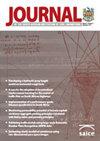利用QGIS和EPANET构建配水网络模型的方法学研究
IF 0.4
4区 工程技术
Q4 ENGINEERING, CIVIL
Journal of the South African Institution of Civil Engineering
Pub Date : 2020-01-01
DOI:10.17159/2309-8775/2020/V62N4A4
引用次数: 3
摘要
本文介绍了一种基于集成免费开源软件(如QGIS和EPANET)和适用于配水网络设计的工程实践的方法方法的发展。使用QGIS和EPANET,以及将其与合理的工程实践和判断相结合,证明既可行又实用,使从业者能够在较小的发展项目或城镇中创建现有管网的配水网络模型。通常,在后一种较小的开发或城镇中,与使用商业许可软件所需的额外时间相关的专业成本可能低于与采购许可软件本身相关的实际成本。因此,与EPANET中传统的手工方法相比,开发的流程流程图不仅可能节省时间和金钱,而且还将为从业者提供指导,并帮助南部非洲面临过时记录和预算限制方面挑战的小型市政当局。据设想,全面方法的实施将有助于改善水基础设施的规划、设计和管理,特别是在水资源匮乏和提供服务仍然是一个紧迫问题的南部非洲。本文章由计算机程序翻译,如有差异,请以英文原文为准。
Methodological approach for the compilation of a water distribution network model using QGIS and EPANET
This paper presents the development of a methodological approach based on the integration of free-of-charge open-source software, e.g. QGIS and EPANET, and engineering practices applicable to water distribution network design. The use of QGIS and EPANET, as well as the integration thereof with sound engineering practices and judgement, proved to be both viable and practical to enable practitioners to create a water distribution network model of an existing network in smaller developments or towns. Typically, in the latter smaller developments or towns, the professional cost associated with the additional time required when commercial licensed software is used, could be lower than the actual cost associated with the procurement of the licensed software itself. Hence, the developed process flow diagrams will not only potentially save time and money in comparison to a traditional, manual approach in EPANET, but will also provide guidance to practitioners and assist smaller municipalities in southern Africa facing challenges in terms of outdated records and budget constraints. It is envisaged that the implementation of the overall methodology will contribute to improved water infrastructure planning, design and management, especially in the southern African context where water resources are scarce and service delivery remains a pressing issue.
求助全文
通过发布文献求助,成功后即可免费获取论文全文。
去求助
来源期刊
CiteScore
0.70
自引率
25.00%
发文量
19
审稿时长
>12 weeks
期刊介绍:
The Journal of the South African Institution of Civil Engineering publishes peer reviewed papers on all aspects of Civil Engineering relevant to Africa. It is an open access, ISI accredited journal, providing authoritative information not only on current developments, but also – through its back issues – giving access to data on established practices and the construction of existing infrastructure. It is published quarterly and is controlled by a Journal Editorial Panel.
The forerunner of the South African Institution of Civil Engineering was established in 1903 as a learned society aiming to develop technology and to share knowledge for the development of the day. The minutes of the proceedings of the then Cape Society of Civil Engineers mainly contained technical papers presented at the Society''s meetings. Since then, and throughout its long history, during which time it has undergone several name changes, the organisation has continued to publish technical papers in its monthly publication (magazine), until 1993 when it created a separate journal for the publication of technical papers.

 求助内容:
求助内容: 应助结果提醒方式:
应助结果提醒方式:


